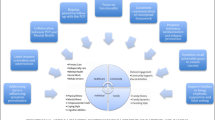Abstract
Psychosomatic symptoms are by definition clinical symptoms with no underlying organic pathology. Common symptoms seen in pediatric age group include abdominal pain, headaches, chest pain, fatigue, limb pain, back pain, worry about health and difficulty breathing. These, more frequently seen symptoms should be differentiated from somatoform or neurotic disorders seen mainly in adults. The prevalence of psychosomatic complaints in children and adolescents has been reported to be between 10 and 25%. These symptoms are theorized to be a response to stress. Potential sources of stress in children and adolescents include schoolwork, family problems, peer pressure, chronic disease or disability in parents, family moves, psychiatric disorder in parents and poor coping abilities. Characteristics that favour psychosomatic basis for symptoms include vagueness of symptoms, varying intensity, inconsistent nature and pattern of symptoms, presence of multiple symptoms at the same time, chronic course with apparent good health, delay in seeking medical care, and lack of concern on the part of the patient. A thorough medical and psychosocial history and physical examination are the most valuable aspects of diagnostic evaluation. Organic etiology for the symptoms must be ruled out. Appropriate mental health consultation should be considered for further evaluation and treatment.
Similar content being viewed by others
References
Reeve A, Strasburger VC: Is it “real” or is it “psychosomatic”? Basic principles of psychosomatic medicine in children and adolescents, 352–366. In Greydanus DE, Wolraich ML, eds.Behavioural Pediatrics. New York, Springer-Verlag, 1992.
International Classification of Diseases (9th Revision): Clinical Modification, 6th edition, Los Angeles, California Practice Management Information Corporation, USA, 2001.
Brown RT: Adolescents with psychosomatic problems. Comprehensive Therapy. 1996; 22: 810.
American Academy of Pediatrics: The Classification of Child and Adolescent Mental Diagnoses in Primary Care: Diagnostic and Statistical Manual for Primary Care (DSM-PC) Child and Adolescent Version. American Academy of Pediatrics. Illinois Elk Grove Village, USA, 1996.
American Psychiatric Association: Diagnostic and Statistical Manual of Mental disorders, 4th edn, Text Revision, Washington DC, American Psychiatric Association, 2001.
Hackett R, Hackett L, Bhakta P, Gowers S: The prevalence and associations of psychiatric disorder in children in Kerala, South India.J Child Psychol Psychiatry. 1999; 40: 801.
Patel V, Pereira J, Mann AH: Somatic and psychological models of common mental disorder in primary care in India.Psychomatic Medicine. 1998; 28: 135.
Alexander PJ, Joseph S, Das A: Limited utility of ICD-10 and DSM-IV classification of dissociative and conversion disorders in India.Acta Psychiatr Scand. 1997; 95: 177.
Chaturvedi SK, Bhandari S, Beena MB, Rao S: Screening for abnormal illness behaviour.Psychopathology. 1996; 29: 325.
Weiss MG, Raguram R, Channabasavanna SM: Cultural dimension of psychiatric diagnosis: a comparison of DSM-III and illness explantory models in south India.British J Psychiatry. 1995; 166: 353.
Srinath S, Bharat S, Girimaji S, Seshadri S: Characteristics of a child inpatient population with hysteria in India.J Am Acad Child Adolesc Psychiatry. 1993; 32: 822.
Singh H, Soni PK, Gill PJS, Kaur L: Stressful family life events and nonspecific somatic complaints in school children.Indian Pediatrics. 1991; 28: 1483.
Greene JW, Walker LS: Psychosomatic problems and stress in adolescence.Pediatric Clinics of North America. 1997; 44: 1557.
Webster ML: Psychological problems manifested by somatic symptoms.Adolescent Medicine. 1998; 9: 403.
Rickert VI, Jay MS: Psychosomatic disorders: the approach.Pediatrics in Review 1994; 15: 448.
Hofmann, AD: Psychosomatic, anxiety and conversion Disorders. In Hofmann AD, Greydanus DE, eds.Adolescent Medicine. Appleton and Lange, Stamford, Connecticut, USA, 1997, pp. 820–834.
Boyce WT: Stress and child health: an overview.Pediatr Ann 1985; 14: 539.
Strasburger VC, Reeve A: The adolescent with chronic pains: basic principles of psychosomatic medicine.Adolescent Medicine. 1991; 2: 677.
Robinson P, Greene Jet al: Functional somatic complaints in adolescents: Relationship to negative life events, self-concept, and family characteristics.Journal of Pediatrics 1988; 113: 588.
Poikolainen K, Kanerva Ret al: Life events and other risk factors for somatic symptoms in adolescence.Pediatrics 1995; 96: 59.
Jemmott JB, Borysenko JZet al: Academic stress, power motivation and decrease in secretion rate of salivary secretory immunoglobulin A.Lancet 1983; 1: 1400.
Natvig GK, Albrektsen Get al: School-related stress and psychosomatic symptoms among school adolescents.J Sch Health 1999; 69: 362.
Rosenfeld W, Walco G: One test too many: toward an integrated approach to psychosomatic disorders.Adolescent Medicine. 1997; 8: 483.
Homnick D, Pratt H: Respiratory diseases with a psychosomatic component in adolescents.Adolescent Medicine. 2000; 11: 547.
Webster ML: Psychological problems manifested by somatic symptoms.Adolescent Medicine. 1998; 9: 403.
Linet M, Stewart W: An epidemiologic study of headache among adolescents and young adults. JAMA 1989; 261: 2211.
Fritz GK, Fritsch S, Hagino O: Somatoform disorders in children and adolescents: a review of the past 10 years.J Am Acad Child Adolesc Psychiatry 1997; 36: 1329.
Author information
Authors and Affiliations
Corresponding author
Rights and permissions
About this article
Cite this article
Brill, S.R., Patel, D.R. & MacDonald, E. Psychosomatic disorders in pediatrics. Indian J Pediatr 68, 597–603 (2001). https://doi.org/10.1007/BF02752270
Issue Date:
DOI: https://doi.org/10.1007/BF02752270




